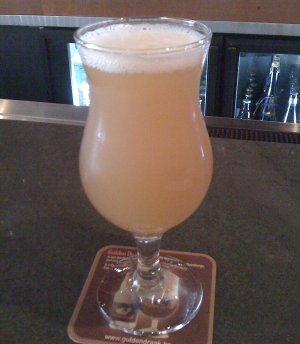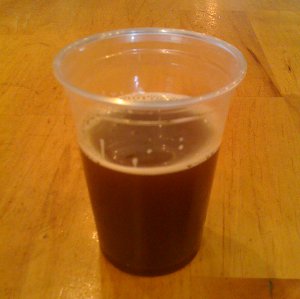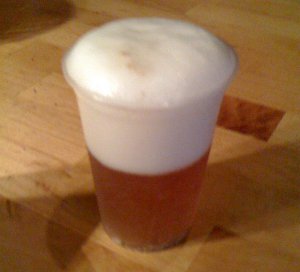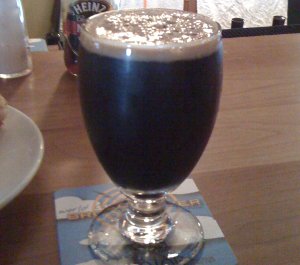Philly Beer Week kicked off last week, but since I’m one of those suburban types, I’m not sure how often I’ll be able to make it into the city for the festivities. Lucky for me, there are quite a few events happening out here in the burbs, so who knows, I may end up filling my schedule with good beer this week.
First up was an event on Saturday that featured Stillwater Artisanal Ales, 12% Importers (who happen to work with Stillwater quite a bit for reasons I’ll get into in a bit), and the Shelton Brothers Importers (who import a crapton of foreign beers, including the likes of Cantillon, Mikkeller, Fantôme and more). The focus of the event was Stillwater, which is another “virtual brewery” (or “gypsy brewer”) like Mikkeller. Brewer Brian Strumke doesn’t have a brewery of his own – he basically schedules time with breweries that have excess capacity and then brews his beers there. It turns out that the majority of his brewing is done at the DOG brewery in Maryland, and he says that once they got up and running, he doesn’t need to be as involved in the day to day brewing activities. He also makes trips over to Belgium and does some limited edition stuff there that is then imported (by the aforementioned 12% importers).
I didn’t get a chance to speak with him that much, but I did ask him why he seemed to primarily brew saisons and how he liked to differentiate his brews from others that specialize in the style. He seems to enjoy the variety that saisons afford, and he also mentioned that he tends to prefer dry beers, as they go much better with food. I get the impression that he really likes working with saison yeast strains as well, as there were a couple beers featured that were not typical saison styles, but which apparently used saison yeast (more on this below). I actually mentioned that I was planning a saison homebrew and was thinking of using the Wyeast 3711 French Saison yeast instead of the 3724 Belgian Saison yeast, and he mentioned that a bunch of his brews used the French Saison yeast and that if I was worried about temperature control (which I am!), that was the way to go. He talked a bit about the first time he used the Belgian Saison yeast and how hot it got during fermentation (upwards of 90 degrees), but he also has access to equipment that is slightly more advanced than my crappy plastic bucket.
I felt kinda dorky asking him about homebrew and I hope I wasn’t being too bothersome, but he seemed to perk up when I asked him about it (I guess it’s better or at least different than the typical questions he gets, which I imagine revolve around his “gypsy” brewing lifestyle). He gave me two pieces of advice when it comes to extract homebrewing (we were talking about saisons and dark Belgian styles): 1. Use the lightest malt extract available and 2. Try to do mini-mash as soon as you’re comfortable with it, because you’re otherwise totally at the mercy of the folks producing the extract (and there’s apparently not much consistency or control over that part of the process). He mentioned how in his early homebrewing days he tried using one of those pots with a built in spaghetti strainer to do a mini-mash (with what I gathered were mixed results, but it was a fun story). I don’t know that I’m quite ready for mini-mash just yet, but it’s something to keep in mind.
Stillwater has only been around for a little over a year, but it’s been getting a lot of attention and garnering a lot of “top new brewer” awards and the like, but Brian seemed to be very down to earth and focused on making good beer. I’m definitely going to be keeping my eyes out for more Stillwater beer in the future. I did manage to sample quite a few of their beers, along with a couple of others during the day (conditions weren’t exactly ideal – most of the below was served in plastic cups, though I did get a glass for the first one):

Stillwater Cellar Door – Apparently the phrase “cellar door” is among the most beautiful sounding phrases in the English language. Pours a hazy light orange color with a fluffy white head. Smells of Belgian yeast and candi. Taste is sweet and spicy with just a hint of citrus. The spice in this was really different and I couldn’t place it, but someone mentioned that it was sage, which makes sense. The mouthfeel is actually very dry (not surprising, given what Brian said), which really just made me want to drink more. Is it my favorite saison ever? Probably not, but it’s really good and distinct from other saison offerings. B+
Beer Nerd Details: 6.6% ABV on tap. Drank out of a tulip glass.
Stillwater Of Love and Regret – This was apparently Brian’s first beer made in Belgium that was then imported back to the US. Pours a bit darker. Smells very fruity and sweet, with a taste to match. There’s a very floral component to the nose that was quite pleasing and complex. And unsurprisingly, it was extremely dry (even moreso than the Cellar Door). It’s a little smoother, and the alcohol is a little stronger. Overall, a pretty good brew. B+
Beer Nerd Details: 7.2% ABV on tap. Drank out of a plastic cup.

Stillwater Jaded – Another Import Series beer made in collaboration with De Struise in Belgium, this is a dark wheat beer brewed with a saison yeast. Beer Advocate just calls it a Belgian Strong Dark Ale, but that belies the complexity of what’s really going on this beer. Pours a deep garnet color with a minimum of head. The nose is filled with dark fruit and sweet malts. Only really a hint of Belgian yeast in the nose. Taste starts sweet and finishes somewhat dry (not as much as the previous, but for a beer this big, it’s relatively dry). Some caramel is apparent in the taste as well. Very smooth beer that’s dangerously drinkable given the high ABV. Overall, my second favorite of the day. A
Beer Nerd Details: 10% ABV on tap. Drank out of a plastic cup.
De Struise Outblack – This is a collaboration between Stillwater and De Struise in Belgium, though I guess De Struise claims this as their own. I didn’t get the full story on this one, but it seems like the recipe was a standard De Struise beer that was modified. Pours very dark with a creamy tan head (good retention). Smells a bit roasty, with just a hint of fruitiness. Taste is sweet and roasty with a nice, sweet finish (not as dry as most of the other beers I had that day). It’s almost stoutish, but not quite. Too much character added by that saison yeast to really call it a stout. Another quite enjoyable beer. B+
Beer Nerd Details: 10% ABV on tap. Drank out of a plastic cup.
Stillwater / Mikkeller Two Gypsies – Our Side – Two of the world’s most famous gypsy brewers collaborating on one beer. Awesome. Pours a cloudy light amber color with about a finger of thick white head. Smell is filled with citrus fruits and hops. Taste is sweet and fruity with just a hint of tartness in the dry finish. It’s not super bitter or anything, but it reminds me a lot of a citrusy pale ale. My favorite beer of the day. A
Beer Nerd Details: 7.5% ABV bottled (I didn’t drink the whole bottle, it was shared!). Drank out of a plastic cup.

Hof Ten Dormaal Blonde – I spoke with the 12% Importer guy (sorry, don’t remember his name!) and he mentioned that this was one of his biggest new imports. It’s apparently made on this crazy self-sustaining farm where the whole brewing/bottling process takes place. Apparently there’s been some issues with carbonation (i.e. there’s lots of it!), but it’s quite good anyway. It’s similar to something like Saison Dupont, but it’s perhaps just a bit dryer. I enjoyed it, but didn’t love it. B+
Beer Nerd Details: 8% ABV bottled (I didn’t drink the whole bottle, it was shared!). Drank out of a plastic cup.
When I was talking to the 12% guy, I noted that the Hof Ten Dormaal and other famous saisons (like the aformentioned Dupont and Fantôme) are all packaged in green bottles, which don’t protect at all from light (which can create off flavors and “skunking”). I asked him if he knew why and he said he wasn’t really sure, but it seemed like a traditional thing. I think I will be sending some more pedantic emails to breweries in the near future!
Overall, a very satisfying experience, and I’ll definitely want to check out a few more Stillwater beers (there are a few that I either didn’t get to or that weren’t available at the event that I do want to try, especially A Saison Darkly, which another patron recommended highly)




